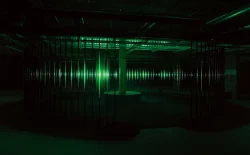Mac Miller’s GO:OD AM dropped last week.
It’s his third official album, his first after leaving indie powerhouse Rostrum Records to sign with Warner Brothers. It’s also his first after hitting a Behind The Music-esque rock bottom and rebuilding himself with the help of Rick Rubin. The two linked after Miller drunk-dialed Rubin, a sentence which both explains and illustrates his level of fame and success.
Mac is also white, although that hasn’t been a factor in his narrative for a long time. No white rapper can ever totally lose their racial asterisk, and as a white person, I’m not qualified to declare anyone’s race a non-issue. But several years into a successful career, with hours logged at The Alchemist’s “rap camp” with Odd Future and friends, Mac has made his whiteness functionally incidental. His race might never have come up had he not broken out in the late 2000s when frat rap was kind of a thing. Being a white dude who liked to party, he got lumped in with the likes of Sammy Adams and Hoodie Allen and subsequently written off. But his talent and creativity allowed him to stick around long enough to outgrow his reputation as a red cup-holding bro hanging out with Donald Trump. As he grew as an artist, he came to be recognized not as a White Rapper but as a rapper who happens to be white.
I think about Mac Miller’s whiteness because Mac comes from the same place I do. I’m not speaking metaphorically; he grew up a five-minute walk away from me down Dallas Ave. in the East End of Pittsburgh, Pennsylvania, in a neighborhood called Point Breeze. We both went to Taylor Allderdice High School in nearby Squirrel Hill (as did Wiz Khalifa, who named a mixtape after it). Our circles overlap a fair amount and he raps about things I did and places I know. Even though I’m almost a decade older, his music resonates with me because we have both been really, really high in Blue Slide Park.
I don’t presume to speak for Mac but I know going to Allderdice helped me understand the complexities of race and class in America and my own privilege. Allderdice — “Dice” for short — is probably the ideal place for a teenager to learn about race and class in America. The student body is 47% white and 40% black (as of 2014). Among the white kids, many come from working class neighborhoods like Greenfield and Lincoln Place and from the large Jewish populations in Squirrel Hill and Point Breeze. That’s not to say Dice is or was a utopian paradise of equality; internal academic tracking works against integration within the school, and you can only do so much to combat outside forces in a city with Pittsburgh’s long history of racism. But the school gives its students plenty of opportunities to get to know people that don’t look like them or didn’t grow up like them. From my years as a student to the current day, Allderdice has fostered a diverse hip-hop community that challenged notions of who rapped and what they rapped about. It’s a central piece of the thriving Pittsburgh scene. Mac looks like half the Pittsburgh rap lifers I know, or knew, or produced for, or DJed with, or bought drugs from, or who hit on someone’s girlfriend at a party in the East End.
But diverse surroundings don’t automatically make someone racially sensitive. Just ask Lil Dicky, a joke rapper whose entire musical career could have been inspired by seeing a black guy make a girl he had a crush on laugh once in eighth grade. He’s obsessed with his “outsider” status in hip-hop, which he perceives to be a direct result of being white. His race comes up in every interview. But Dicky ground this axe all the way to the top: his Professional Rapper album, which he funded through a Kickstarter, hit number one in the Billboard rap charts and featured Snoop Dogg and T-Pain. He’s a graduate of Cheltenham High School in the first ring suburbs of Philadelphia. Cheltenham’s student body is is 51% black and 37% white.
The problem for white rappers is you can’t separate hip-hop and blackness. Not to downplay the contributions of the many, many whites, Asians, Latinos, etc. to the genre, nor to disregard the legitimacy of, say, the healthy Chicano or Egyptian rap scenes, but for almost four decades, rap has been largely sustained by the ideas, creativity and energy of black people. And in a country founded on white supremacy and black slavery, a loud, clear black voice is in and of itself radical: there’s a reason why so many of those protesting police violence against the black community across America this year were chanting Lil Boosie and Kendrick Lamar, not Bob Dylan or Arlo Guthrie. (Apologies for whitesplaining, but there are people that still need this all spelled out.)
That’s not to say white people aren’t “allowed” to rap (and Lord knows we’re gonna do it anyways!), but doing so takes some self-awareness and respect. You don’t get props for going to somebody’s house and not stealing shit or telling them their furniture is ugly, and so Mac Miller’s ability to have a successful hip-hop career without offending anybody shouldn’t necessarily be celebrated. But Miley Cyrus is on TV rocking fake dreads like it’s OK and a cappella groups don’t understand that covering ‘Trap Queen’ is only funny and cute if you think getting shot by an overzealous cop who is still on the job despite four previous complaints about excessive force is funny and cute. While T.I. may have finally had enough of Iggy Azalea’s bullshit, she still moved a lot of units while playing dress-up as a black woman from East Atlanta.
Mac got this far without having to issue a public apology. At the very least, he deserves some golf claps for reminding everyone it’s not impossible.































